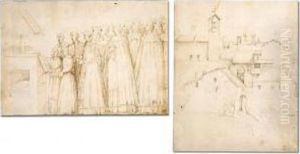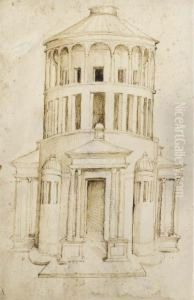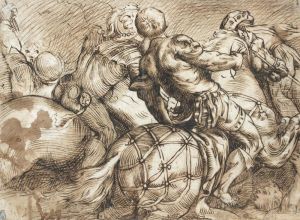Pseudo Pacchia Paintings
Pseudo Pacchia is an enigmatic figure in the realm of art history, primarily because the name does not refer to an individual artist, but rather to a stylistic attribution given to a group of artworks that were once believed to be by or related to the Sienese painter Girolamo del Pacchia (1477 – c. 1533). The term 'Pseudo' in art history is often used to categorize works that were previously misattributed to a known artist but later recognized as having been created by another, unidentified artist or group of artists whose style closely mimics or derives from the original artist's work. In the case of Pseudo Pacchia, this designation helps scholars and art historians distinguish between the genuine works of Girolamo del Pacchia and those that exhibit similar stylistic characteristics but are now understood not to have been made by him.
The body of work attributed to Pseudo Pacchia encompasses a range of paintings and possibly some drawings that reflect the stylistic tendencies and thematic preferences of the early 16th century in Siena. These works are characterized by their adherence to the High Renaissance ideals of balanced composition, clear form, and a refined approach to depicting the human figure, all of which were hallmarks of Girolamo del Pacchia’s work as well. However, upon closer examination, differences in technique, brushwork, and sometimes quality suggest that these works were not by Pacchia himself but by contemporaries or followers who were influenced by his style.
The precise identity or identities of the artists behind Pseudo Pacchia remain unknown. Attempts to pinpoint individual artists or a specific workshop have been speculative at best. The use of the term 'Pseudo' thus serves as a useful, if temporary, classification, allowing scholars to acknowledge the influence of Girolamo del Pacchia while recognizing the distinct contributions of these unidentified artists to the Sienese Renaissance.
Art historians and scholars continue to study these works, hoping to uncover more about the artists and the specific circumstances under which they were created. The investigation into Pseudo Pacchia not only sheds light on the complexities of artistic attribution but also emphasizes the interconnectedness of artists’ workshops in Renaissance Italy, where ideas, styles, and techniques were fluidly exchanged. Despite the anonymity, the works attributed to Pseudo Pacchia contribute to our understanding of the diversity and richness of Renaissance art, highlighting the importance of recognizing and studying not just the master artists but also the broader network of talents that shaped the period’s artistic landscape.


